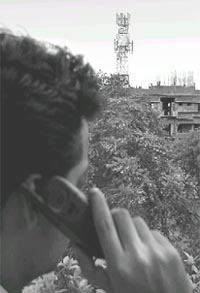Broadbanding the waves
 engineers at Lucent Laboratories, in the us, have found a way to increase data carrying capacity of radio signals by six fold.
engineers at Lucent Laboratories, in the us, have found a way to increase data carrying capacity of radio signals by six fold.
The unprecedented growth in the use of communication devices has meant that the demand for carrying capacity or bandwidth is almost insatiable. Television, radio and mobile phone networks are all claiming parts of the electromagnetic spectrum for their sole use. This bandwidth crunch is going to get worse, as mobile networks graduate to data intensive transmission like surfing the web or even email. Till now, the companies wishing to expand their services had to get permits for the use of the electromagnetic spectrum from regulatory authorities.
Electromagnetic spectrum ranges from extremely short wavelengths of gamma rays to very long wavelengths used in radio transmission. A wave is made up of oscillating electric and magnetic fields. The fields oscillate perpendicular to the direction of propagation of the wave and are perpendicular to each other. The direction of oscillation of the electric field determines the state of polarisation of the wave. Any wave can have two states of polarisation. To see this, imagine attaching a string or a rope to a wall and oscillating it. The oscillations are in a direction perpendicular to the rope. Now one pass the rope through a cardboard piece with a slit cut in it. In this case, the oscillations will be in the direction of the slit. This wave would thus be polarised and the slit would at as a polariser. It is theoretically possible to send two independent signals with different polarisations and catch them using two antennae with proper orientation. However, this is rarely done in practical transmission.
M Andrews and his collaborators have now made it possible. Normally, when the mobile phone transmitter sends a signal to a mobile phone, the signal reflects off buildings and other objects in the way before finally reaching the receiving phone. The signals come to the phone from all possible directions. Andrews and his team have shown that one can use three antennas to transmit polarised signals where each of the signals has two polarisation states. The three antennas are installed in three mutually perpendicular directions to each other. These signals are reflected off the objects and arrive at the mobile phone receiver. Here with the help of three antennas, the signals can be reformatted (Nature , 409, p316).
The scientists have made a prototype of the device and used it over a distance of 25 meters with the signals transmitted at 880 Megahertz. They used it to transmit a painting using the three channels to transmit red, blue and green colours of the painting. The receiver was placed around the corner and picked up the signals reflected off the walls.
When the technology is commercially viable the cellular phone companies will be able to increase their bandwidth by about six times without buying extra channels in the electromagnetic spectrum. Given that the technology for sending and receiving data rich signals already exists, this could lead to an explosion of such services.
